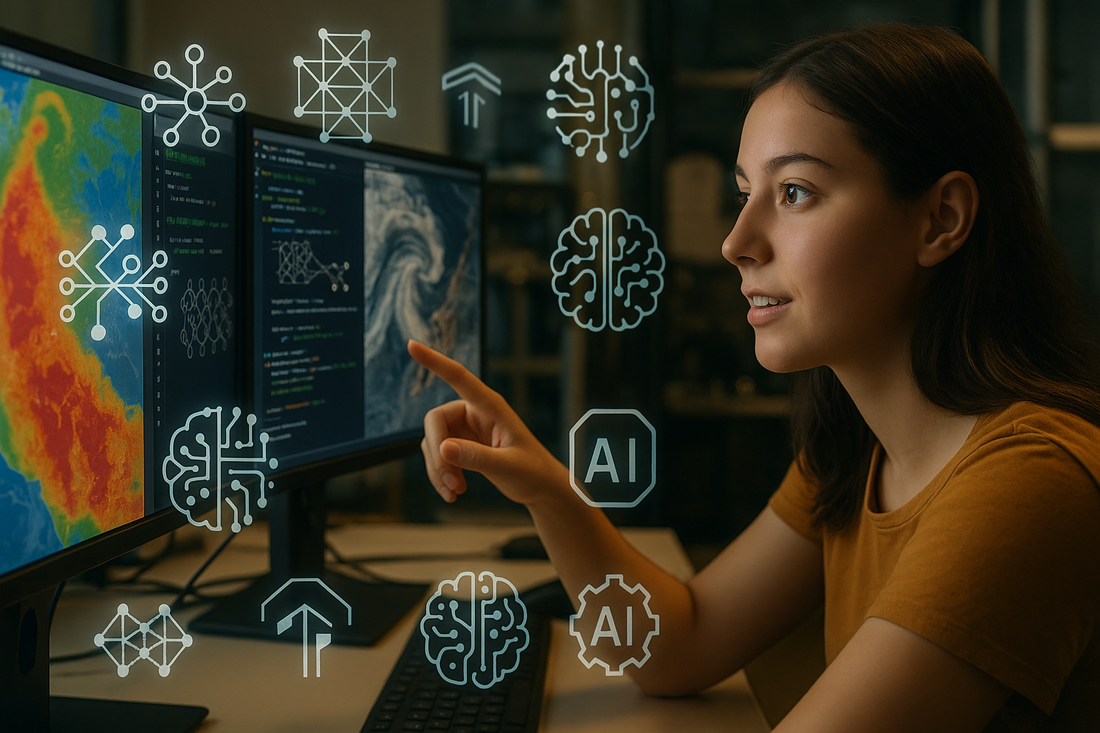
From Weather Nerd to AI Wildfire Detective: A Young Meteorologist's Journey into Climate Prediction
Why would a 20-year-old decide to dedicate her life to predicting where the world might literally catch fire?
For Sarah Ember, it started with a TikTok video. During her second year studying meteorology, she stumbled across footage of the 2024 California wildfires that turned its skyline apocalyptic orange. But what struck her wasn't the dramatic visuals—it was her professor's quiet frustration the next day: "We can predict hurricanes a week out, but wildfires? We're still playing catch-up."
That's when Sarah realised she wanted to be part of changing that.
When Weather Meets Code
Growing up, Sarah was that kid who checked three different weather apps obsessively. Her friends thought she was weird. Her parents hoped it was a phase.
Plot twist: it wasn't.
Traditional meteorology felt limited to her. They'd spend hours analysing atmospheric pressure charts, but wildfire prediction still relied on outdated models. The Calafornia Fire Weather Index they learned about was developed in the 1970s—her phone had more computing power than those original systems.
Then Sarah discovered that researchers were using artificial intelligence to revolutionise wildfire prediction. Israeli scientists had developed an AI model that could predict lightning-induced wildfires with over 90% accuracy. The European Centre for Medium-Range Weather Forecasts created "Probability of Fire" (PoF) that could forecast wildfire occurrence globally up to ten days in advance.
Suddenly, her obsession with atmospheric pressure patterns and late-night coding sessions seemed like they could actually save lives.
Learning AI While Speaking Atmosphere
Sarah's first attempt at building a machine learning model was... educational. She tried feeding historical temperature data into a basic Python script, convinced she could predict wildfire risk for her hometown.
Spoiler alert: she could not.
But failure proved a fantastic teacher. Sarah learned that effective wildfire prediction involves fuel moisture, vegetation types, topography, human activity patterns, and dozens of variables traditional meteorology barely touched. AI doesn't replace atmospheric science - it amplifies it by finding patterns humans would never spot manually.
She spent her summer break teaching herself TensorFlow and PyTorch. While friends worked at coffee shops, Sarah trained neural networks on satellite imagery, identifying fire-prone vegetation patterns. Her parents definitely thought she'd lost it when they found her explaining convolutional neural networks to their cat at 2AM.
The Tools That Changed Everything
The breakthrough came when Sarah discovered ECMWF's Probability of Fire model. Unlike traditional approaches using preset weather indices, PoF uses machine learning to process vast amounts of satellite data, weather patterns, and environmental factors simultaneously. It forecasts fire occurrence globally at high resolution - something traditional methods would take weeks to calculate.
Sarah started working with MODIS satellite data, the same imagery NASA uses to track wildfires globally. Python libraries like NumPy and Pandas made processing massive datasets surprisingly manageable. The real game-changer was understanding that modern wildfire prediction combines multiple AI approaches: convolutional neural networks process satellite imagery, lightning prediction models like NOAA's LightningCast forecast where lightning-induced fires are most likely, and generative AI models simulate fire spread scenarios.
It's like having a crystal ball built from atmospheric physics and machine learning, instead of mysticism.
Why This Matters
Last month, Sarah presented her undergraduate research on AI-enhanced fire weather prediction. The response was incredible, but what really hit her was a visiting researcher's comment about the 2024 California fires: "We lost entire communities because we didn't see the fires coming fast enough. What you're working on isn't just academic - this is about giving families time to evacuate."
Climate change is making wildfires more frequent and intense globally. Traditional forecasting methods weren't designed for this new reality. AI offers tools to process modern fire behaviour complexity in ways human analysis simply can't match.
European researchers found that high-quality data - vegetation moisture and fuel availability information - is crucial for improving forecast accuracy. AI excels at integrating these diverse data sources into coherent predictions, identifying patterns across millions of data points in real time.
The Learning Curve
Building expertise in AI wildfire prediction means mastering both domains. You need solid atmospheric science fundamentals - pressure systems, atmospheric moisture, wind patterns - plus programming skills, statistical knowledge, and machine learning architecture familiarity.
Sarah's currently developing a neural network combining local weather station data with satellite imagery to predict fire weather conditions 72 hours in advance, specifically designed for her region's unique vegetation and climate patterns.
The goal isn't replacing human meteorologists - it's giving them superpowers. AI handles data processing and pattern recognition that would take humans weeks. Meteorologists provide atmospheric science expertise and contextual understanding that AI still struggles with.
The Future Is On Fire
The field evolves rapidly. Companies like Climavision develop AI weather models 30% more accurate globally than traditional European models. USC researchers use generative AI to predict wildfire spread in real-time.
Most exciting is how accessible these tools are becoming. Open-source frameworks like TensorFlow and PyTorch give meteorology students access to professional research tools. NASA and ESA satellite data is freely available. The barrier isn't technology - it's willingness to bridge atmospheric science with computer science.
The Real Motivation
People often ask Sarah why she chose such a specific specialisation. Her answer is simple: she wants to help solve one of climate change's most visible and dangerous consequences.
Every summer, communities evacuate ahead of approaching fires, from Spain to Greece - the lower slopes of Signal Hill could be next. Every fire season, smoke plumes stretch across continents. Traditional forecasting gives hours or days of warning. AI-enhanced prediction could provide weeks.
The climate is changing, but so are our predictive tools. AI won't stop wildfires, but it might give us the power to save lives and protect communities.
Sarah used to be just a weather nerd who coded in her spare time. Now she's training to be an AI wildfire detective—and she's never been more excited about atmospheric pressure patterns in her life.
